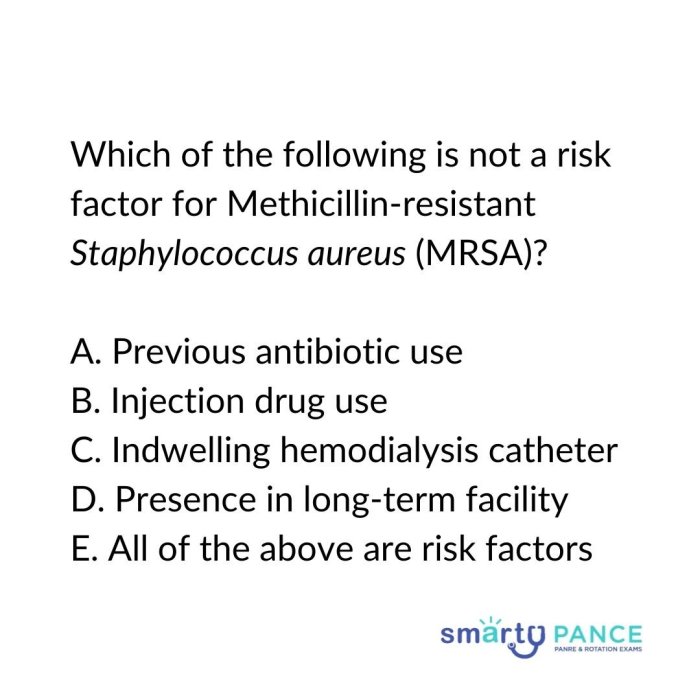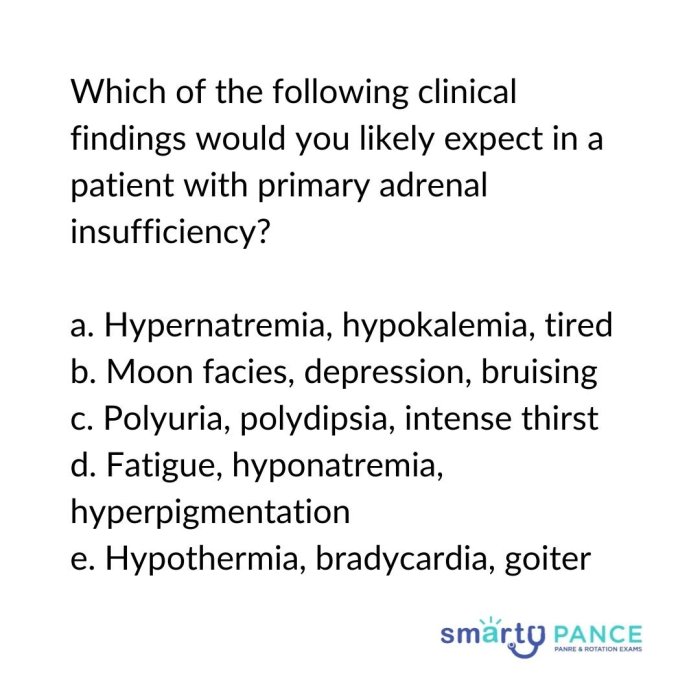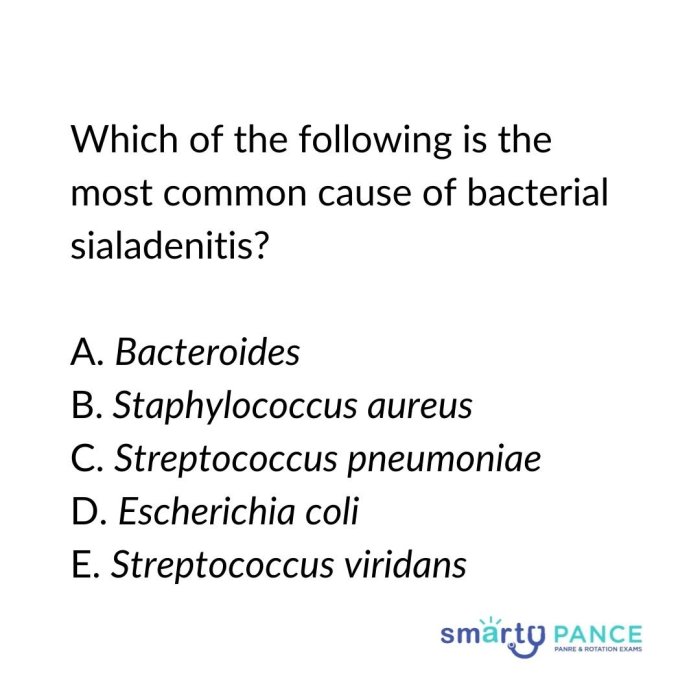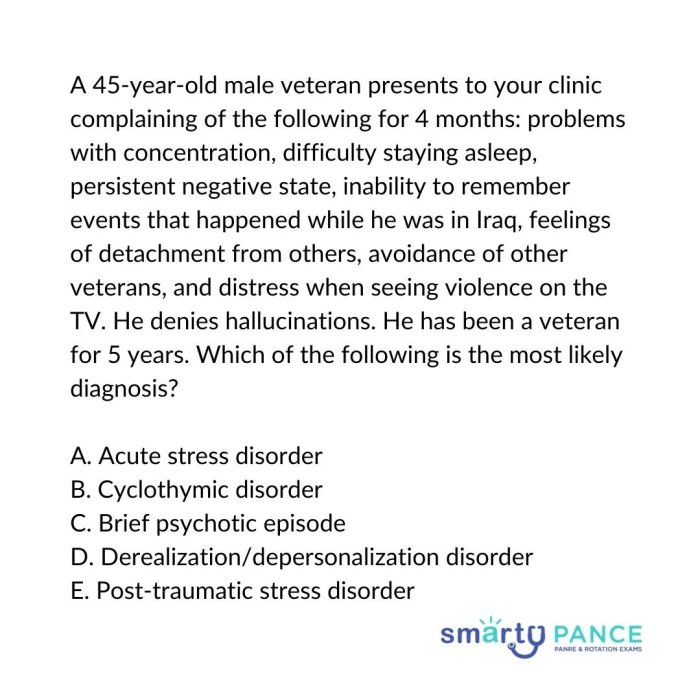The PANCE Question of the Day embarks on a captivating journey, guiding you through the intricate world of Physician Assistant National Certifying Examination (PANCE) preparation. This comprehensive exploration unravels the secrets of answering PANCE questions with precision, empowering you to conquer this challenging exam with confidence.
Delve into the depths of PANCE question structure, uncovering the patterns and strategies that lead to success. Master the art of deciphering question stems, navigate the diverse range of medical specialties, and harness the power of clinical vignettes to enhance your diagnostic abilities.
PANCE Question Breakdown

PANCE questions come in various formats, each with a specific structure and purpose. Understanding the question stem is crucial as it provides the context and focus of the question.
Question Formats
- Single Best Answer (SBA):Select the single most appropriate answer from a list of options.
- Multiple Choice:Select all correct answers from a list of options.
- True/False:Determine whether a statement is true or false.
- Case-Based:Analyze a clinical scenario and answer questions related to diagnosis, management, or patient education.
Question Stem
The question stem is the initial part of the question that sets the context and provides instructions. It typically includes:
- Patient Presentation:Describes the patient’s symptoms, history, and physical exam findings.
- Question Prompt:Asks a specific question about the patient’s condition, management, or prognosis.
- Negation:May include words like “except” or “not” to indicate that a certain answer is incorrect.
Carefully reading and understanding the question stem helps you identify the key information needed to answer the question correctly.
Today’s PANCE question is a bit of a head-scratcher, but it’s nothing that a little research can’t solve. Speaking of research, have you ever wondered about the origins of the Pi Kappa Phi hand sign ? It’s a fascinating story that dates back to the early days of the fraternity.
Anyway, back to the PANCE question…
PANCE Question Content

The PANCE exam covers a wide range of medical topics, with a focus on high-yield areas that are commonly encountered in clinical practice. These topics include:
- Cardiovascular
- Pulmonary
- Gastrointestinal
- Genitourinary
- Musculoskeletal
- Neurology
- Dermatology
- Psychiatry
- Preventive Medicine
The distribution of questions across different medical specialties is as follows:
| Specialty | Percentage of Questions |
|---|---|
| Internal Medicine | 40-50% |
| Family Medicine | 25-35% |
| Pediatrics | 15-25% |
| Surgery | 5-10% |
| Other | 0-5% |
Clinical vignettes are used in PANCE questions to provide context and simulate real-world clinical scenarios. These vignettes typically describe a patient’s presentation, medical history, and physical exam findings. Candidates are then asked to answer questions about the patient’s diagnosis, treatment, and management.
PANCE Question-Answering Strategies

Tackling PANCE questions requires a systematic approach that combines critical thinking, problem-solving skills, and strategic elimination of incorrect choices. Follow these steps to maximize your chances of success:
Step-by-Step Approach
- Read the question carefully:Identify the key concepts, patient presentation, and desired outcome.
- Consider the patient’s history and presentation:Analyze the relevant information to form a differential diagnosis.
- Review the answer choices:Eliminate any obviously incorrect options based on the patient’s presentation.
- Apply critical thinking:Evaluate the remaining choices using your knowledge and clinical reasoning skills.
- Choose the best answer:Select the option that most accurately aligns with the patient’s condition and the question’s intent.
Critical Thinking and Problem-Solving Skills, Pance question of the day
PANCE questions test your ability to apply medical knowledge in real-world scenarios. Engage in critical thinking by:
- Analyzing the patient’s presentation and symptoms
- Formulating a differential diagnosis
- Evaluating the pros and cons of each answer choice
- Applying logical reasoning to determine the most likely diagnosis or treatment
Eliminating Incorrect Answer Choices
To increase your accuracy, eliminate incorrect answer choices by:
- Identifying options that are irrelevant to the patient’s presentation
- Recognizing options that contain incorrect or outdated information
- Choosing options that are consistent with the patient’s history and symptoms
PANCE Question Review and Analysis: Pance Question Of The Day

Thoroughly reviewing and analyzing PANCE practice questions is crucial for exam preparation. This section provides resources and strategies to enhance your question review process, enabling you to identify areas for improvement and refine your understanding of key concepts.
Question Bank Comparison
Choosing the right question bank is essential for effective preparation. Consider the following factors when comparing different options:
| Feature | Importance |
|---|---|
| Number of Questions | Provides a sufficient number of questions to practice and identify areas for improvement. |
| Question Quality | Ensures questions are up-to-date, relevant, and reflect the actual PANCE exam format. |
| Answer Explanations | Provides detailed explanations for correct and incorrect answers, aiding in understanding concepts. |
| Performance Tracking | Tracks progress and identifies areas for improvement through personalized feedback. |
| Cost | Fits within your budget and provides value for the price. |
Resources for Finding and Reviewing Questions
Utilize these resources to find and review PANCE practice questions:
- Official PANCE website
- Medical education websites (e.g., UpToDate, Medscape)
- Question banks from reputable publishers (e.g., Kaplan, BoardVitals)
- Free online resources (e.g., PANCE Prep Pearls, Quizlet)
- Peer-reviewed journals
Discussion Forum
Engage in discussions and collaborate with other PANCE candidates by joining or creating a discussion forum. Share questions, discuss strategies, and learn from the experiences of others.
Query Resolution
What is the most effective way to approach PANCE questions?
Adopting a systematic approach that involves carefully analyzing the question stem, identifying key concepts, and eliminating incorrect answer choices can significantly improve your accuracy.
How can I improve my critical thinking skills for PANCE questions?
Regularly engaging in practice questions and analyzing their rationale will enhance your ability to think critically and apply your medical knowledge to real-world scenarios.
What are the benefits of using question banks for PANCE preparation?
Question banks provide a vast repository of practice questions that simulate the actual exam experience, allowing you to identify areas for improvement and reinforce your understanding of key concepts.